Integrating the Water Footprint and DPSIR Model to Evaluate Agricultural Water Sustainability in Arid Regions: A Case Study of the Turpan–Hami Basin
Abstract
1. Introduction
2. Materials and Methods
2.1. Study Area
2.2. Data Sources
2.3. Water Footprint Accounting
2.4. DPSIR Model Framework
2.5. Evaluation Method
3. Results
3.1. Agricultural Water Footprint in the Turpan–Hami Basin
3.1.1. Agricultural Water Footprint by Color and Crop Type
3.1.2. Water Resource Stress and Economic Benefit
3.2. Evaluation of Water Resource Sustainability
3.2.1. Weighting of DPSIR Model Indicators and Criterion Layers
3.2.2. Sustainability Status of Water Resources
4. Discussion
4.1. Water Footprint in the Arid Regions
4.2. Sustainability Assessment of Water Resources Using the DPSIR Model
4.3. Improvements and Limitations
5. Conclusions
Author Contributions
Funding
Data Availability Statement
Conflicts of Interest
References
- Konar, M.; Dalin, C.; Suweis, S.; Hanasaki, N.; Rinaldo, A.; Rodriguez-Iturbe, I. Water for food: The global virtual water trade network. Water Resour. Res. 2011, 47, W05520. [Google Scholar] [CrossRef]
- Elbeltagi, A.; Deng, J.; Wang, K.; Hong, Y. Crop Water footprint estimation and modeling using an artificial neural network approach in the Nile Delta, Egypt. Agric. Water Manag. 2020, 235, 106080. [Google Scholar] [CrossRef]
- Olesen, J.E.; Bindi, M. Consequences of climate change for European agricultural productivity, land use and policy. Eur. J. Agron. 2002, 16, 239–262. [Google Scholar] [CrossRef]
- Fader, M.; Gerten, D.; Thammer, M.; Heinke, J.; Lotze-Campen, H.; Lucht, W.; Cramer, W. Internal and external green-blue agricultural water footprints of nations, and related water and land savings through trade. Hydrol. Earth Syst. Sci. 2011, 15, 1641–1660. [Google Scholar] [CrossRef]
- Marston, L.; Konar, M. Drought impacts to water footprints and virtual water transfers of the Central Valley of California. Water Resour. Res. 2017, 53, 5756–5773. [Google Scholar] [CrossRef]
- Yu, Y.; Pi, Y.; Yu, X.; Ta, Z.; Sun, L.; Disse, M.; Zeng, F.; Li, Y.; Chen, X.; Yu, R. Climate change, water resources and sustainable development in the arid and semi-arid lands of Central Asia in the past 30 years. J. Arid Land 2018, 11, 1–14. [Google Scholar] [CrossRef]
- Hoekstra, A.Y. Human appropriation of natural capital: A comparison of ecological footprint and water footprint analysis. Ecol. Econ. 2009, 68, 1963–1974. [Google Scholar] [CrossRef]
- Mekonnen, M.M.; Hoekstra, A.Y. The green, blue and grey water footprint of crops and derived crop products. Hydrol. Earth Syst. Sci. 2011, 15, 1577–1600. [Google Scholar] [CrossRef]
- Chapagain, A.K.; Hoekstra, A.Y. The water footprint of coffee and tea consumption in the Netherlands. Ecol. Econ. 2007, 64, 109–118. [Google Scholar] [CrossRef]
- Chapagain, A.K.; Hoekstra, A.Y.; Savenije, H.H.G.; Gautam, R. The water footprint of cotton consumption: An assessment of the impact of worldwide consumption of cotton products on the water resources in the cotton producing countries. Ecol. Econ. 2006, 60, 186–203. [Google Scholar] [CrossRef]
- Chen, J.; Gao, Y.; Qian, H.; Jia, H.; Zhang, Q. Insights into water sustainability from a grey water footprint perspective in an irrigated region of the Yellow River Basin. J. Clean. Prod. 2021, 316, 128329. [Google Scholar] [CrossRef]
- Arrien, M.M.; Aldaya, M.M.; Rodriguez, C.I. Water Footprint and Virtual Water Trade of Maize in the Province of Buenos Aires, Argentina. Water 2021, 13, 1769. [Google Scholar] [CrossRef]
- Cao, X.; Bao, Y.; Li, Y.; Li, J.; Wu, M. Unravelling the effects of crop blue, green and grey virtual water flows on regional agricultural water footprint and scarcity. Agric. Water Manag. 2023, 278, 108165. [Google Scholar] [CrossRef]
- Arunrat, N.; Sereenonchai, S.; Chaowiwat, W.; Wang, C. Climate change impact on major crop yield and water footprint under CMIP6 climate projections in repeated drought and flood areas in Thailand. Sci. Total Environ. 2022, 807, 150741. [Google Scholar] [CrossRef]
- Tuninetti, M.; Tamea, S.; D’Odorico, P.; Laio, F.; Ridolfi, L. Global sensitivity of high-resolution estimates of crop water footprint. Water Resour. Res. 2015, 51, 8257–8272. [Google Scholar] [CrossRef]
- Hu, Y.; Duan, W.; Chen, Y.; Zou, S.; Kayumba, P.M.; Qin, J. Exploring the changes and driving forces of water footprint in Central Asia: A global trade assessment. J. Clean. Prod. 2022, 375, 134062. [Google Scholar] [CrossRef]
- Liu, J.; Chen, J.; Xu, J.; Yuan, Z.; Wang, Y.; Lin, Y. Water resource security evaluation of the Yangtze River Economic Belt. Water Supply 2020, 20, 1554–1566. [Google Scholar] [CrossRef]
- Gao, J.; Xie, P.; Zhuo, L.; Shang, K.; Ji, X.; Wu, P. Water footprints of irrigated crop production and meteorological driving factors at multiple temporal scales. Agric. Water Manag. 2021, 255, 107014. [Google Scholar] [CrossRef]
- Jin, C.; Huang, K.; Yu, Y.; Zhang, Y. Analysis of Influencing Factors of Water Footprint Based on the STIRPAT Model: Evidence from the Beijing Agricultural Sector. Water 2016, 8, 513. [Google Scholar] [CrossRef]
- Feng, L.; Chen, B.; Hayat, T.; Alsaedi, A.; Ahmad, B. Dynamic forecasting of agricultural water footprint based on Markov Chain-a case study of the Heihe River Basin. Ecol. Model. 2017, 353, 150–157. [Google Scholar] [CrossRef]
- Zhang, L.; Yu, Y.; Guo, Z.; Ding, X.; Zhang, J.; Yu, R. Investigating agricultural water sustainability in arid regions with Bayesian network and water footprint theories. Sci. Total Environ. 2024, 951, 175544. [Google Scholar] [CrossRef] [PubMed]
- Borja, Á.; Galparsoro, I.; Solaun, O.; Muxika, I.; Tello, E.M.; Uriarte, A.; Valencia, V. The European Water Framework Directive and the DPSIR, a methodological approach to assess the risk of failing to achieve good ecological status. Estuar. Coast. Shelf Sci. 2006, 66, 84–96. [Google Scholar] [CrossRef]
- Zhang, F.; Zhang, J.; Wu, R.; Ma, Q.; Yang, J. Ecosystem health assessment based on DPSIRM framework and health distance model in Nansi Lake, China. Stoch. Environ. Res. Risk Assess. 2015, 30, 1235–1247. [Google Scholar] [CrossRef]
- Huang, H.; Kuo, J.; Lo, S. Review of PSR framework and development of a DPSIR model to assess greenhouse effect in Taiwan. Environ. Monit. Assess. 2010, 177, 623–635. [Google Scholar] [CrossRef]
- Malekmohammadi, B.; Jahanishakib, F. Vulnerability assessment of wetland landscape ecosystem services using driver-pressure-state-impact-response (DPSIR) model. Ecol. Indic. 2017, 82, 293–303. [Google Scholar] [CrossRef]
- Atkins, J.P.; Burdon, D.; Elliott, M.; Gregory, A.J. Management of the marine environment: Integrating ecosystem services and societal benefits with the DPSIR framework in a systems approach. Mar. Pollut. Bull. 2011, 62, 215–226. [Google Scholar] [CrossRef]
- Sekovski, I.; Newton, A.; Dennison, W.C. Megacities in the coastal zone: Using a driver-pressure-state-impact-response framework to address complex environmental problems. Estuar. Coast. Shelf Sci. 2012, 96, 48–59. [Google Scholar] [CrossRef]
- Namaalwa, S.; Van Dam, A.A.; Funk, A.; Ajie, G.S.; Kaggwa, R.C. A characterization of the drivers, pressures, ecosystem functions and services of Namatala wetland, Uganda. Environ. Sci. Policy 2013, 34, 44–57. [Google Scholar] [CrossRef]
- Wen, T.; Qi, S.; Qian, Y. Index measurement and analysis on spatial-temporal evolution of China’s new economy based on the DPSIR model. Int. Rev. Econ. Financ. 2024, 90, 252–264. [Google Scholar] [CrossRef]
- Lu, W.; Xu, C.; Wu, J.; Cheng, S. Ecological effect assessment based on the DPSIR model of a polluted urban river during restoration: A case study of the Nanfei River, China. Ecol. Indic. 2019, 96, 146–152. [Google Scholar] [CrossRef]
- Maxim, L.; Spangenberg, J.H.; O’Connor, M. An analysis of risks for biodiversity under the DPSIR framework. Ecol. Econ. 2009, 69, 12–23. [Google Scholar] [CrossRef]
- Jia, Y.; Wang, H. Study on Water Resource Carrying Capacity of Zhengzhou City Based on DPSIR Model. Int. J. Environ. Res. Public Health 2023, 20, 1394. [Google Scholar] [CrossRef] [PubMed]
- Bai, Y.; Qin, J.; Liu, W.; Li, L.; Wu, Y.; Zhang, P. The DPSIR Model-Based Sustainability Assessment of Urban Water Resources: A Comparative Study of Zhuhai and Macao. Water 2024, 16, 1413. [Google Scholar] [CrossRef]
- Shi, S.; Tao, X.; Chen, X.; Chen, H.; Fitri, A.; Yang, X. Evaluation of urban water security based on DPSIR model. IOP Conf. Ser. Earth Environ. Sci. 2021, 880, 012023. [Google Scholar] [CrossRef]
- Li, Y.; Liu, Y.; Qin, Y.; Zhang, K.; Enwer, R.; Wang, W.; Yuan, S. Evolution and Predictive Analysis of Spatiotemporal Patterns of Habitat Quality in the Turpan–Hami Basin. Land 2024, 13, 2186. [Google Scholar] [CrossRef]
- Zhang, Q.; Yan, M.; Zhang, L.; Shao, W.; Chen, Y.; Dong, Y. Three Decades of Oasis Transition and Its Driving Factors in Turpan–Hami Basin in Xinjiang, China: A Complex Network Approach. Remote Sens. 2024, 16, 465. [Google Scholar] [CrossRef]
- Shao, W.; Li, L.; Yan, M.; Meng, Z.; Zhang, L.; Zhang, Q.; Chen, Y. Thirty years’ spatio-temporal evolution of desertification degrees and driving factors in Turpan–Hami Basin, Xinjiang, China. Ecol. Indic. 2024, 166, 112484. [Google Scholar] [CrossRef]
- Xinjiang Statistical Yearbook. Available online: https://tjj.xinjiang.gov.cn/tjj/zhhvgh/list_nj1.shtml (accessed on 1 May 2022).
- Statistical Bulletin on the National Economic and Social Development of Turpan. Available online: https://www.tlf.gov.cn/tlfs/index.shtml (accessed on 1 March 2024).
- Statistical Bulletin on the National Economic and Social Development of Hami. Available online: https://www.hami.gov.cn/hami/index.shtml (accessed on 1 March 2024).
- Xinjiang Water Resources Bulletin. Available online: https://slt.xinjiang.gov.cn/xjslt/c114491/zfxxgk_list.shtml (accessed on 22 March 2022).
- Environmental Quality Standards for Surface Water. Available online: https://www.mee.gov.cn/ (accessed on 1 May 2023).
- Dang, Y.; Qin, L.; Huang, L.; Wang, J.; Li, B.; He, H. Water footprint of rain-fed maize in different growth stages and associated climatic driving forces in Northeast China. Agric. Water Manag. 2022, 263, 107463. [Google Scholar] [CrossRef]
- Martinez-Paz, J.M.; Gomariz-Castillo, F.; Pellicer-Martinez, F. Appraisal of the water footprint of irrigated agriculture in a semi-arid area: The Segura River Basin. PLoS ONE 2018, 13, e0206852. [Google Scholar] [CrossRef]
- Novoa, V.; Ahumada-Rudolph, R.; Rojas, O.; Saez, K.; de la Barrera, F.; Arumi, J.L. Understanding agricultural water footprint variability to improve water management in Chile. Sci. Total Environ. 2019, 670, 188–199. [Google Scholar] [CrossRef]
- Cui, S.; Dong, H.; Wilson, J. Grey water footprint evaluation and driving force analysis of eight economic regions in China. Environ. Sci. Pollut. Res. Int. 2020, 27, 20380–20391. [Google Scholar] [CrossRef] [PubMed]
- Yu, H.; Yang, Z.; Li, B. Sustainability Assessment of Water Resources in Beijing. Water 2020, 12, 1999. [Google Scholar] [CrossRef]
- Alizadeh, Z.; Yazdi, J.; Moridi, A. Development of an Entropy Method for Groundwater Quality Monitoring Network Design. Environ. Process. 2018, 5, 769–788. [Google Scholar] [CrossRef]
- Krishnan, A.R.; Kasim, M.M.; Hamid, R.; Ghazali, M.F. A Modified CRITIC Method to Estimate the Objective Weights of Decision Criteria. Symmetry 2021, 13, 973. [Google Scholar] [CrossRef]
- Zhang, L.; Yu, Y.; Malik, I.; Wistuba, M.; Sun, L.; Yang, M.; Wang, Q.; Yu, R. Water Resources Evaluation in Arid Areas Based on Agricultural Water Footprint—A Case Study on the Edge of the Taklimakan Desert. Atmosphere 2023, 14, 67. [Google Scholar] [CrossRef]
- Shen, Y.; Li, S.; Chen, Y.; Qi, Y.; Zhang, S. Estimation of regional irrigation water requirement and water supply risk in the arid region of Northwestern China 1989–2010. Agric. Water Manag. 2013, 128, 55–64. [Google Scholar] [CrossRef]
- El-Marsafawy, S.M.; Mohamed, A.I. Water footprint of Egyptian crops and its economics. Alex. Eng. J. 2021, 60, 4711–4721. [Google Scholar] [CrossRef]
- Khan, T.; Nouri, H.; Booij, M.; Hoekstra, A.; Khan, H.; Ullah, I. Water Footprint, Blue Water Scarcity, and Economic Water Productivity of Irrigated Crops in Peshawar Basin, Pakistan. Water 2021, 13, 1249. [Google Scholar] [CrossRef]
- Huang, S.; Krysanova, V.; Zhai, J.; Su, B. Impact of Intensive Irrigation Activities on River Discharge Under Agricultural Scenarios in the Semi-Arid Aksu River Basin, Northwest China. Water Resour. Manag. 2014, 29, 945–959. [Google Scholar] [CrossRef]
- Zhao, D.; Liu, W.; Gao, R.; Zhang, P.; Li, M.; Wu, P.; Zhuo, L. Spatiotemporal evolution of crop grey water footprint and associated water pollution levels in arid regions of western China. Agric. Water Manag. 2023, 280, 108224. [Google Scholar] [CrossRef]
- Barbier, E.B. Water and Economic Growth. Econ. Rec. 2004, 80, 1–16. [Google Scholar] [CrossRef]
- Duarte, R.; Pinilla, V.; Serrano, A. Looking backward to look forward: Water use and economic growth from a long-term perspective. Appl. Econ. 2013, 46, 212–224. [Google Scholar] [CrossRef]
- Davijani, M.H.; Banihabib, M.E.; Anvar, A.N.; Hashemi, S.R. Multi-Objective Optimization Model for the Allocation of Water Resources in Arid Regions Based on the Maximization of Socioeconomic Efficiency. Water Resour. Manag. 2016, 30, 927–946. [Google Scholar] [CrossRef]
- Al-Muqdadi, S.W.H.; Khalaifawi, A.; Abdulrahman, B.; Kittana, F.A.; Alwadi, K.Z.; Abdulkhaleq, M.H.; Al Saffar, S.S.; Al Taie, S.M.; Merza, S.; Al Dahmani, R. Exploring the challenges and opportunities in the Water, Energy, Food nexus for Arid Region. J. Sustain. Dev. Energy Water Environ. Syst. 2021, 9, 1–30. [Google Scholar] [CrossRef]
- Wang, Y.; Cui, X.; Zhang, X.; Wen, Q. Exploring the Sustainable Use Strategy of Scarce Water Resources for Rural Revitalization in Yanchi County from Arid Region of Northwest China. Int. J. Environ. Res. Public Health 2022, 19, 16347. [Google Scholar] [CrossRef]
- Mao, Y.; Liu, Y.; Zhuo, L.; Wang, W.; Li, M.; Feng, B.; Wu, P. Quantitative evaluation of spatial scale effects on regional water footprint in crop production. Resour. Conserv. Recycl. 2021, 173, 105709. [Google Scholar] [CrossRef]
- Zhang, X.; Wang, Z.; Liu, J.; Li, W.; Lin, H.; Javed, T.; Gao, X.; Qin, G.; Liu, H.; Wang, H.; et al. Spatial–Temporal Dynamics and Drivers of Crop Water Footprint in Xinjiang, China. Agronomy 2025, 15, 296. [Google Scholar] [CrossRef]
- Pei, H.; Fang, S.; Lin, L.; Qin, Z.; Wang, X. Methods and applications for ecological vulnerability evaluation in a hyper-arid oasis: A case study of the Turpan Oasis, China. Environ. Earth Sci. 2015, 74, 1449–1461. [Google Scholar] [CrossRef]
- Zoumides, C.; Bruggeman, A.; Hadjikakou, M.; Zachariadis, T. Policy-relevant indicators for semi-arid nations: The water footprint of crop production and supply utilization of Cyprus. Ecol. Indic. 2014, 43, 205–214. [Google Scholar] [CrossRef]
- Zhang, Y.; Wei, Y.; Mao, Y. Sustainability Assessment of Regional Water Resources in China Based on DPSIR Model. Sustainability 2023, 15, 8015. [Google Scholar] [CrossRef]
- Alharbi, S.; Felemban, A.; Abdelrahim, A.; Al-Dakhil, M. Agricultural and Technology-Based Strategies to Improve Water-Use Efficiency in Arid and Semiarid Areas. Water 2024, 16, 1842. [Google Scholar] [CrossRef]
- Chukalla, A.D.; Krol, M.S.; Hoekstra, A.Y. Green and blue water footprint reduction in irrigated agriculture: Effect of irrigation techniques, irrigation strategies and mulching. Hydrol. Earth Syst. Sci. 2015, 19, 4877–4891. [Google Scholar] [CrossRef]
- Wang, W.; Zhuo, L.; Li, M.; Liu, Y.; Wu, P. The effect of development in water-saving irrigation techniques on spatial-temporal variations in crop water footprint and benchmarking. J. Hydrol. 2019, 577, 123916. [Google Scholar] [CrossRef]
- Galaverni, M.; Oddi, G.; Preite, L.; Belli, L.; Davoli, L.; Marchioni, I.; Rodolfi, M.; Solari, F.; Beghè, D.; Ganino, T.; et al. An IoT-based data analysis system: A case study on tomato cultivation under different irrigation regimes. Comput. Electron. Agric. 2025, 229, 109660. [Google Scholar] [CrossRef]
- Preite, L.; Solari, F.; Vignali, G. Water Management Optimization in Agriculture: A Digital Model Development. Water Resour. Manag. 2025, 39, 1261–1279. [Google Scholar] [CrossRef]
- Xu, X.; Zhang, Y.; Chen, Y. Projecting China’s future water footprint under the shared socio-economic pathways. J. Environ. Manag. 2020, 260, 110102. [Google Scholar] [CrossRef]

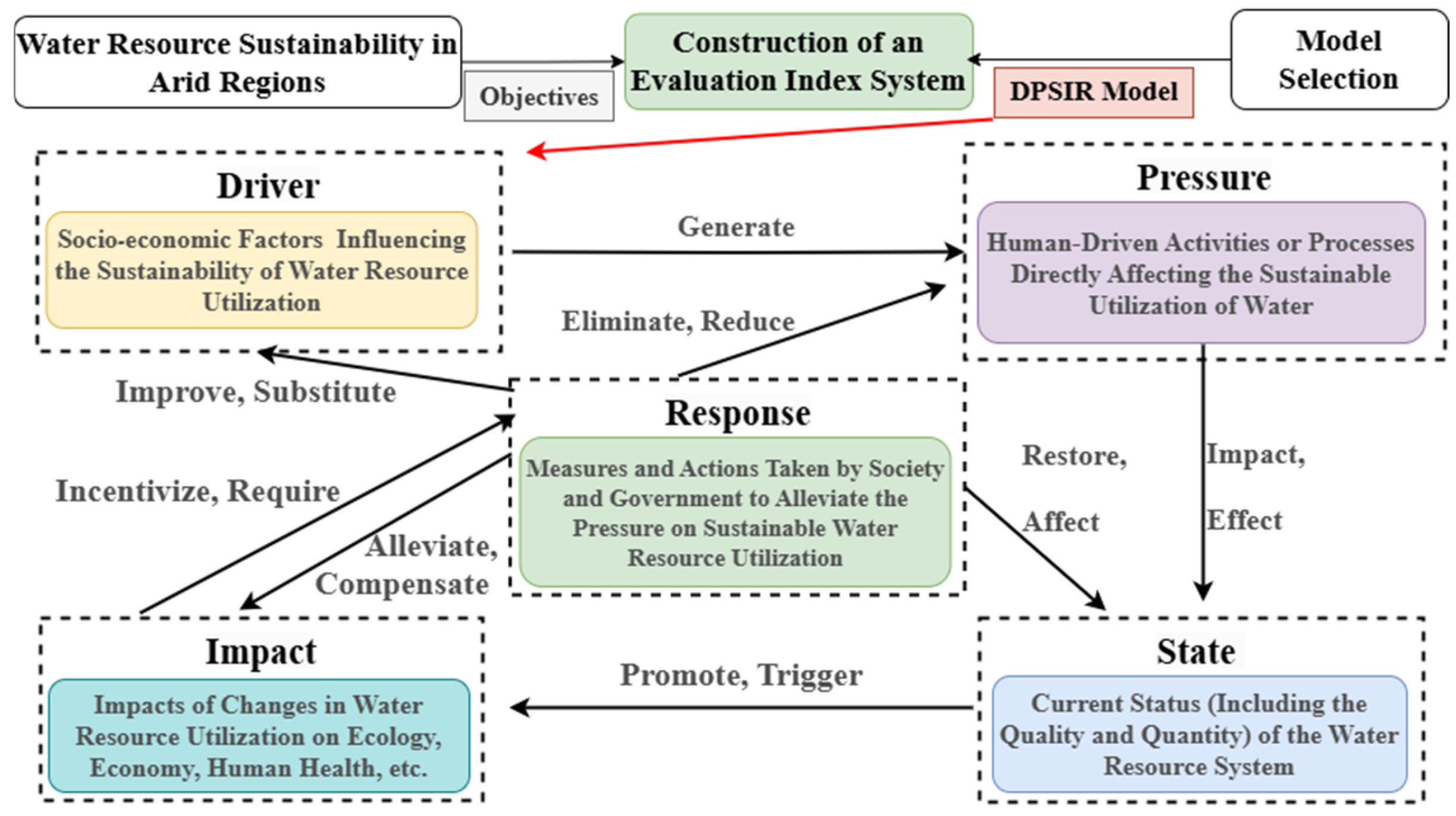
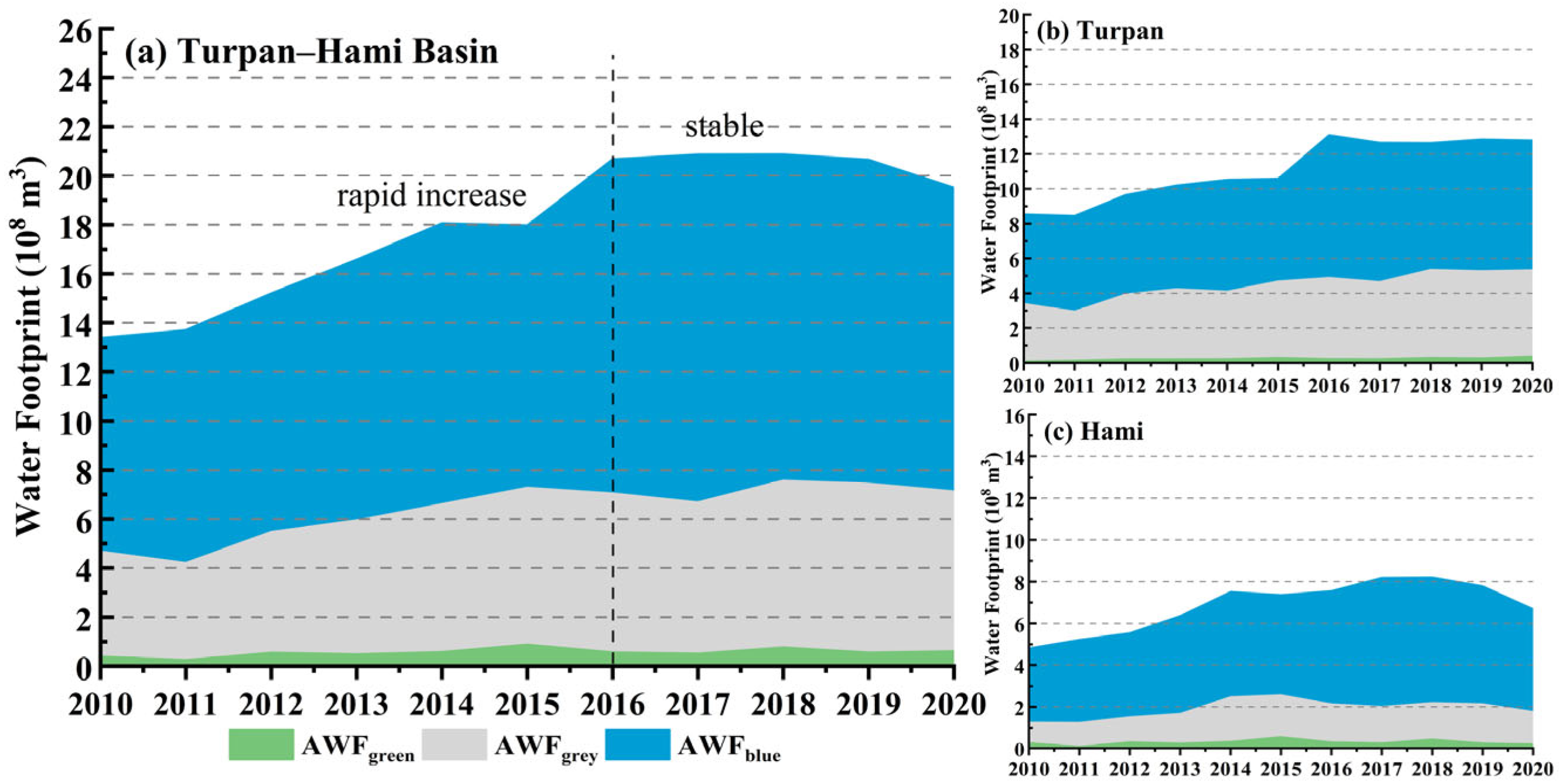
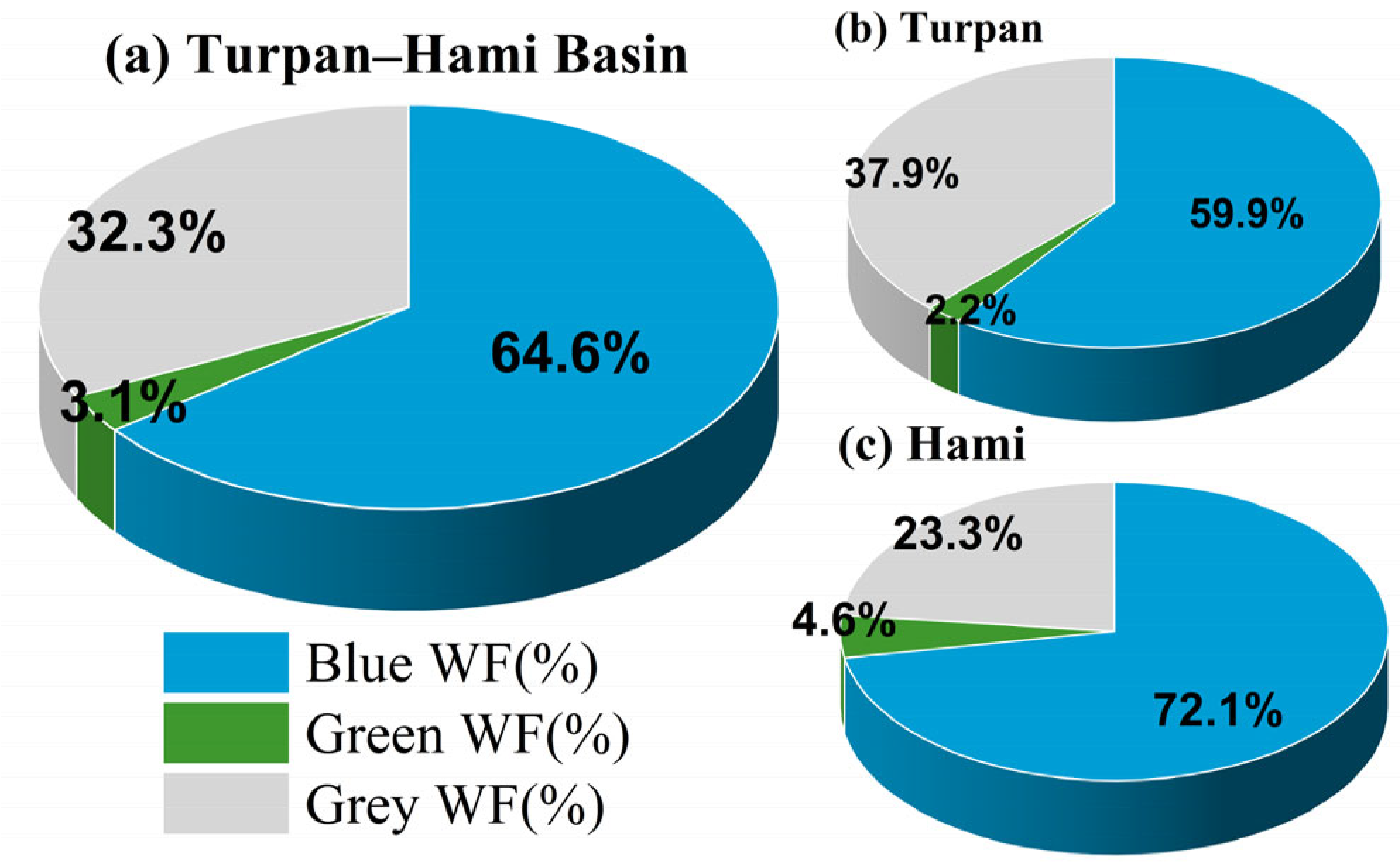

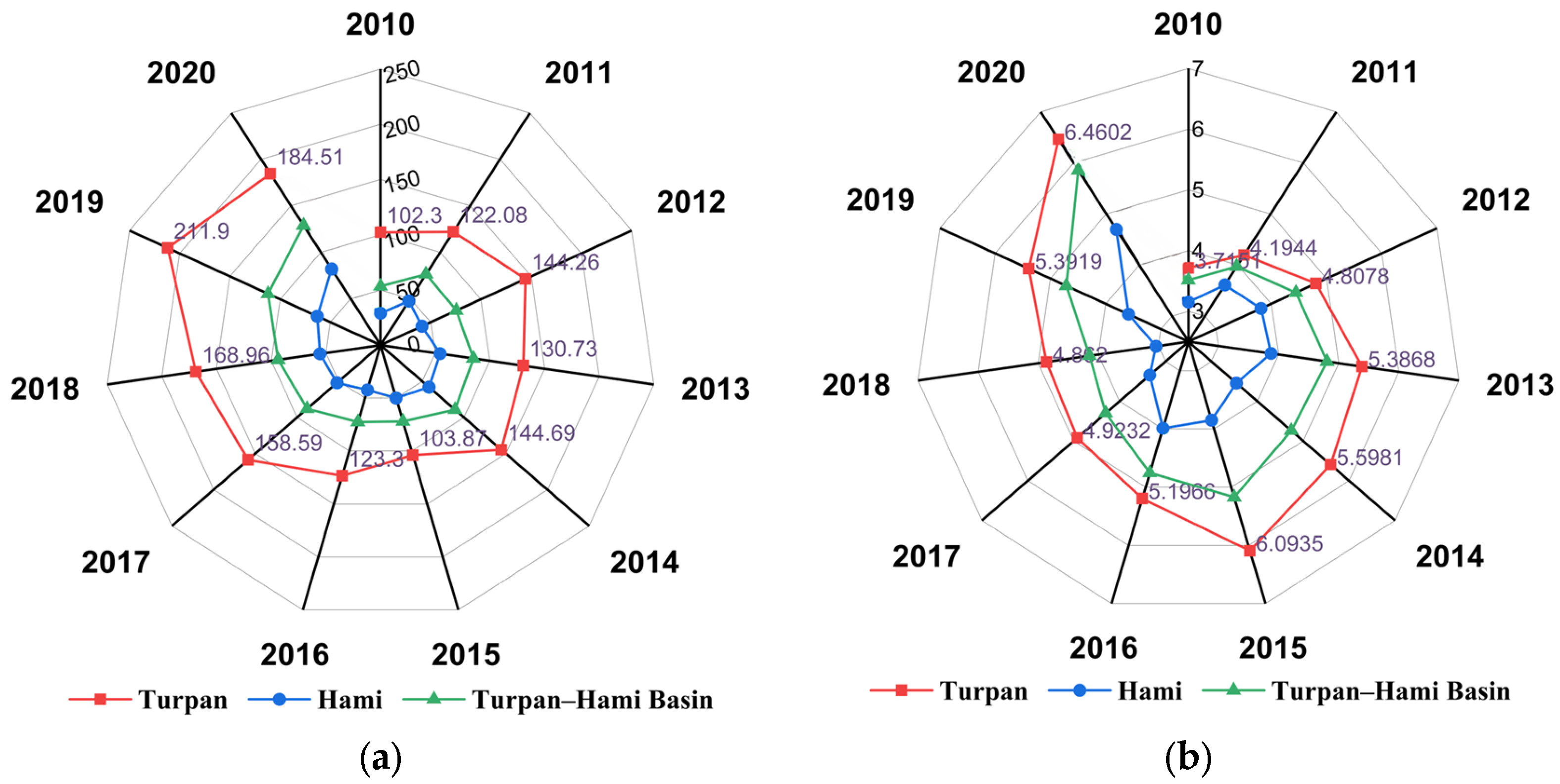

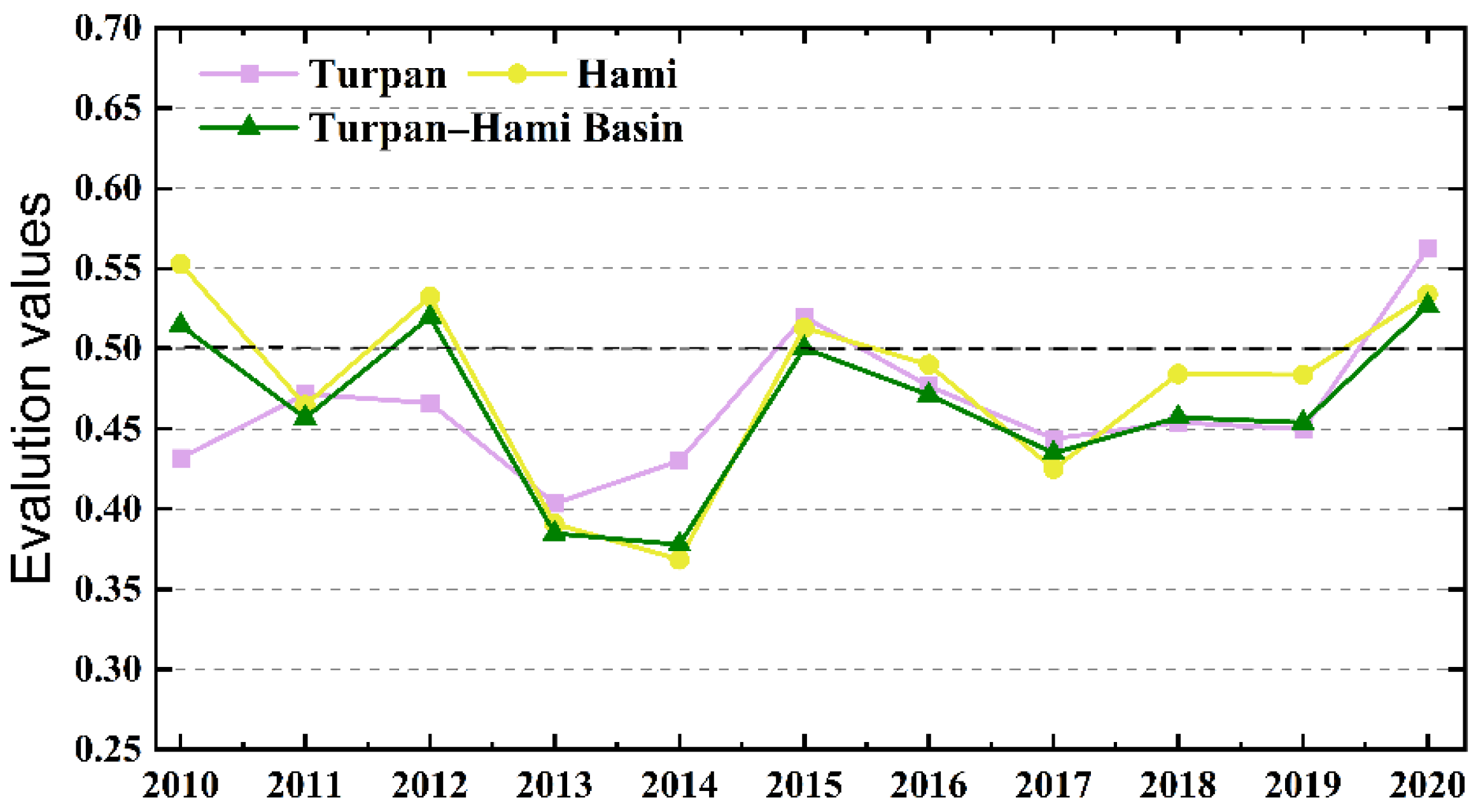
| Type | Indicators | Unit | Calculation Method | Code | Attribute |
|---|---|---|---|---|---|
| Driver (D) | Population Density | person/km2 | Population/Area | D1 | negative |
| Per Capita GDP | CNY/person | GDP/Population | D2 | positive | |
| Planting Area | ha | - | D3 | negative | |
| Crop Yield | ton | - | D4 | positive | |
| Proportion of Agricultural Output | % | Agricultural Output/GDP | D5 | positive | |
| Pressure (P) | Water Utilization Rate | % | Water use/Water resources × 100% | P1 | negative |
| Water Footprint Modulus | m3/km2 | AWF/Area | P2 | negative | |
| Nitrogen Amount | ton | - | P3 | negative | |
| Proportion of Blue WF | % | AWFblue/AWF × 100% | P4 | negative | |
| Proportion of Green WF | % | AWFgreen/AWF × 100% | P5 | positive | |
| Proportion of Grey WF | % | AWFgrey/AWF × 100% | P6 | negative | |
| State (S) | Per Capita Water Resources | m3/person | Water resources/Population | S1 | positive |
| Per Capita WF | m3/person | AWF/Population | S2 | negative | |
| Water Scarcity Index | % | AWF/Water resources × 100% | S3 | negative | |
| Precipitation | mm | - | S4 | positive | |
| Total Power of Agricultural Machinery | kW | - | S5 | positive | |
| Impact (I) | Economic Benefit of WF | CNY/m3 | GDP/AWF | I1 | positive |
| Per Capita Water Use | m3/person | Water use/Population | I2 | negative | |
| Water Quality Shortage Index | - | AWFgrey/Water resources | I3 | negative | |
| Per Capita Urban Green Space | m2/person | Park Green Space/Population | I4 | positive | |
| Response (R) | Proportion of Environmental Water Use | % | Environmental Water Use/Water use | R1 | positive |
| Soil Erosion Control Area | ha | - | R2 | positive | |
| Afforested Area | ha | - | R3 | positive | |
| Water-Saving Irrigation Area | ha | - | R4 | positive | |
| Investment in Environmental Pollution Control | 104 CNY | - | R5 | positive |
| Evaluation Score | 0.00–0.17 | 0.17–0.33 | 0.33–0.50 | 0.50–0.67 | 0.68–0.83 | 0.83–1.00 |
|---|---|---|---|---|---|---|
| Evaluation Level | VI | V | IV | III | II | I |
| Evaluation Criteria | Unsustainable | Moderately Unsustainable | Insufficiently Sustainable | Basically Sustainable | Sustainable | Highly Sustainable |
| Indicators | Turpan | Hami | Turpan–Hami Basin | |||
|---|---|---|---|---|---|---|
| Code | Subsystem Weight | Combination Weight | Subsystem Weight | Combination Weight | Subsystem Weight | Combination Weight |
| D1 | 0.1765 | 0.1483 | 0.1940 | 0.1381 | 0.1857 | 0.1416 |
| D2 | 0.2219 | 0.2171 | 0.2103 | |||
| D3 | 0.1721 | 0.2697 | 0.2125 | |||
| D4 | 0.2588 | 0.2345 | 0.2306 | |||
| D5 | 0.1988 | 0.1406 | 0.2049 | |||
| P1 | 0.2431 | 0.1469 | 0.2279 | 0.1522 | 0.2493 | 0.1765 |
| P2 | 0.2352 | 0.2187 | 0.2458 | |||
| P3 | 0.1793 | 0.1457 | 0.1832 | |||
| P4 | 0.1393 | 0.2127 | 0.1283 | |||
| P5 | 0.1290 | 0.1336 | 0.1277 | |||
| P6 | 0.1704 | 0.1371 | 0.1384 | |||
| S1 | 0.1973 | 0.2357 | 0.1908 | 0.1344 | 0.2056 | 0.1413 |
| S2 | 0.2676 | 0.2855 | 0.2978 | |||
| S3 | 0.1447 | 0.1201 | 0.1241 | |||
| S4 | 0.1784 | 0.2503 | 0.2101 | |||
| S5 | 0.1736 | 0.2097 | 0.2267 | |||
| I1 | 0.1363 | 0.2055 | 0.1618 | 0.2220 | 0.1348 | 0.2152 |
| I2 | 0.2627 | 0.2208 | 0.2544 | |||
| I3 | 0.2888 | 0.2473 | 0.2744 | |||
| I4 | 0.2431 | 0.3099 | 0.2560 | |||
| R1 | 0.2468 | 0.2373 | 0.2256 | 0.2315 | 0.2246 | 0.2495 |
| R2 | 0.2311 | 0.2701 | 0.2574 | |||
| R3 | 0.1489 | 0.1776 | 0.1674 | |||
| R4 | 0.1610 | 0.1630 | 0.1249 | |||
| R5 | 0.2217 | 0.1578 | 0.2008 | |||
Disclaimer/Publisher’s Note: The statements, opinions and data contained in all publications are solely those of the individual author(s) and contributor(s) and not of MDPI and/or the editor(s). MDPI and/or the editor(s) disclaim responsibility for any injury to people or property resulting from any ideas, methods, instructions or products referred to in the content. |
© 2025 by the authors. Licensee MDPI, Basel, Switzerland. This article is an open access article distributed under the terms and conditions of the Creative Commons Attribution (CC BY) license (https://creativecommons.org/licenses/by/4.0/).
Share and Cite
Zhang, L.; Yu, Y.; Guo, Z.; Ding, X.; Sun, L.; He, J.; Li, C.; Yu, R. Integrating the Water Footprint and DPSIR Model to Evaluate Agricultural Water Sustainability in Arid Regions: A Case Study of the Turpan–Hami Basin. Agronomy 2025, 15, 1393. https://doi.org/10.3390/agronomy15061393
Zhang L, Yu Y, Guo Z, Ding X, Sun L, He J, Li C, Yu R. Integrating the Water Footprint and DPSIR Model to Evaluate Agricultural Water Sustainability in Arid Regions: A Case Study of the Turpan–Hami Basin. Agronomy. 2025; 15(6):1393. https://doi.org/10.3390/agronomy15061393
Chicago/Turabian StyleZhang, Lingyun, Yang Yu, Zengkun Guo, Xiaoyun Ding, Lingxiao Sun, Jing He, Chunlan Li, and Ruide Yu. 2025. "Integrating the Water Footprint and DPSIR Model to Evaluate Agricultural Water Sustainability in Arid Regions: A Case Study of the Turpan–Hami Basin" Agronomy 15, no. 6: 1393. https://doi.org/10.3390/agronomy15061393
APA StyleZhang, L., Yu, Y., Guo, Z., Ding, X., Sun, L., He, J., Li, C., & Yu, R. (2025). Integrating the Water Footprint and DPSIR Model to Evaluate Agricultural Water Sustainability in Arid Regions: A Case Study of the Turpan–Hami Basin. Agronomy, 15(6), 1393. https://doi.org/10.3390/agronomy15061393







